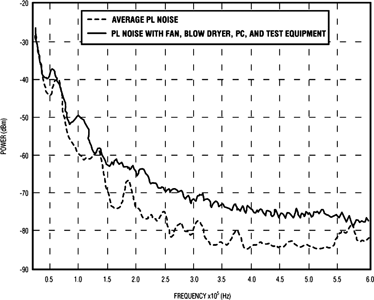
Maxim has introduced the MAX2990 OFDM-based, power-line communication (PLC) modem.
This device employs advanced broadband-communication techniques to deliver cost-effective, two-way data communication over AC and DC power lines at speeds up to 100 Kbps. By using existing power lines, it reduces the need for external cables to interconnect between network nodes.
Supporting a wide, 10 kHz to 490 kHz frequency range, the device complies with international power-line signalling regulations, including CENELEC, FCC and ARIB. This highly integrated SoC is suitable for applications requiring high data rates over long distances, such as automatic meter reading (AMR), energy management and load control, lighting control, and building, industrial and home automation.
The challenge of communicating through existing power lines
The power-line network is by far the largest network in the world. While the idea of using power lines for communication goes back to the 1920s, the number of communication devices installed on dedicated wires far exceeds the number installed on AC power lines today.
Power lines are hostile environments. The lower, 10 kHz to 500 kHz frequency region is especially susceptible to interference, background noise, impulsive noise, and group delays. Figure 1 shows the average noise in a typical power-line channel.

To overcome these challenges, many companies have tried different modulation techniques such as spread spectrum and other narrowband schemes. None of these solutions achieve high data rates reliably over the long distances required by today’s demanding applications.
OFDM and advanced networking technologies ensure robust data communication
Maxim has solved the problems inherent to PLC by applying broadband communication techniques. The MAX2990 uses OFDM technology with DBPSK modulation and forward error correction (FEC) to provide robust data communication in the presence of narrowband interferers, group delays, jammer signals, impulsive noise and frequency-selective attenuations.
Advanced networking techniques ensure a reliable, highly secure communications network. Specifically, a CSMA/CA scheme controls the data traffic flow in multiple-node distributed networks, and an automatic repeat request (ARQ) function ensures the delivery and receipt of incoming packets. The MAX2990 also integrates a fast DES encryption/decryption coprocessor to enhance data security.
Improved bandwidth utilisation maximises data recovery
Figure 2 compares a narrowband technology, such as FSK, to a broadband technology, such as OFDM. These two technologies differ in the number of tones that each uses to transmit data per symbol (a symbol is the smallest unit of data transmitted at one time). The graph illustrates that OFDM uses bandwidth more efficiently than a narrowband method, thereby allowing more tones to be transmitted for a given bandwidth.

The higher number of tones available from OFDM systems enables the MAX2990 to implement data-recovery schemes such as Reed Solomon and convolutional encoding. These advanced channel-coding techniques provide error-correction bits that can be transmitted with the data on different tones to maximise data recovery.
Superior performance at higher data rates
When evaluating a modem, one of the most significant values to consider is the bit-error rate (BER) at a given signal-to-noise ratio (SNR). The BER is the ratio of the lost bits to the transmitted bits at a certain noise level.
Whereas a typical FSK system has a BER of approximately 10-4 at 12 dB SNR with a data rate of 2 Kbps, the MAX2990 achieves the same BER at 4 dB SNR with data rates of 32 Kbps in Cenelec bands between 10 kHz and 95 kHz. Thus, using OFDM technology with error-correction techniques enables an 8 dB improvement in performance at much higher data rates.
To further improve performance, the MAX2990 automatically switches to robust mode when input-signal variations exceed predefined thresholds, such as SNR levels, input-fluctuation levels, and potential in-band tone reductions. As a result, this mode achieves 5 dB improvement in SNR, but at lower data rates.
The MAX2990 combines the physical (PHY) and media access control (MAC) layers in a single chip that also integrates Maxim’s 16-bit RISC MAXQ microcontroller. The MAX2990 includes 32 KB of Flash memory to run the MAC code and user-defined custom applications, plus 8 KB of SRAM for data memory. Additionally, it supports UART, SPI and I²C serial interfaces for glueless communication between the power line and other devices on the network.
For more information contact CST Electronics, +27 (0)11 608 0070, [email protected], www.cstelectronics.co.za
| Tel: | +27 11 608 0070 |
| Email: | [email protected] |
| www: | www.cstelectronics.co.za |
| Articles: | More information and articles about CST Electronics |

© Technews Publishing (Pty) Ltd | All Rights Reserved